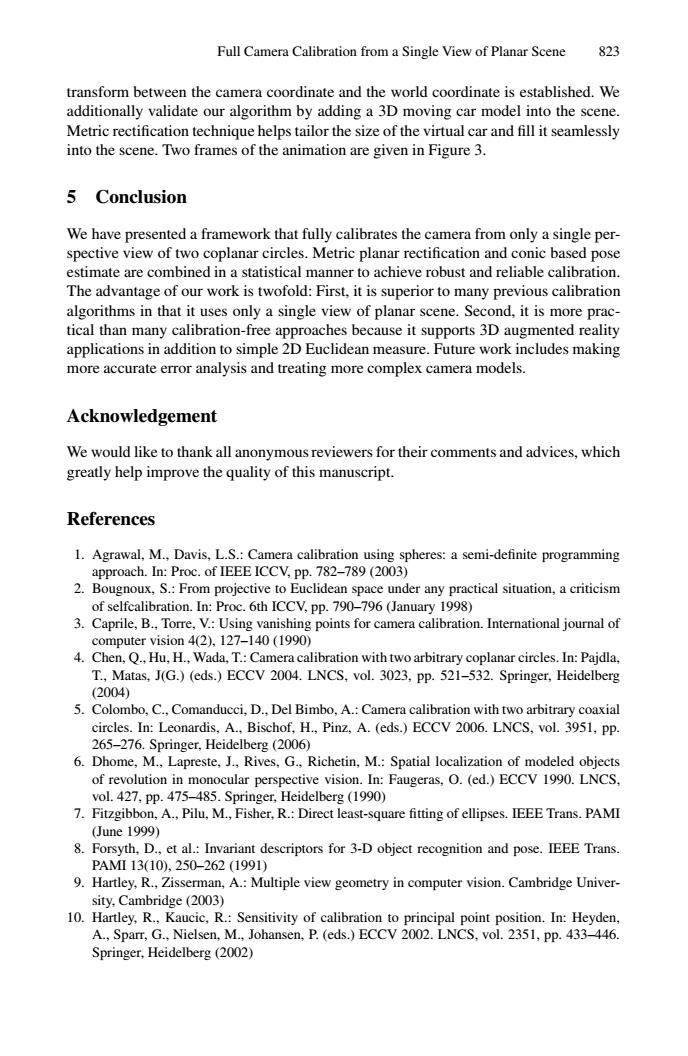正在加载图片...

Full Camera Calibration from a Single View of Planar Scene 823 transform between the camera coordinate and the world coordinate is established.We additionally validate our algorithm by adding a 3D moving car model into the scene. Metric rectification technique helps tailor the size of the virtual car and fill it seamlessly into the scepe.Two frames of the animation are given in Figure 3. 5 Conclusion We have presented a framework that fully calibrates the camera from only a single per- spective view of two coplanar circles.Metric planar rectification and conic based pose estimate are combined in a statistical manner to achieve robust and reliable calibration. The advantage of our work is twofold:First,it is superior to many previous calibration algorithms in that it uses only a single view of planar scene.Second,it is more prac- tical than many calibration-free approaches because it supports 3D augmented reality applications in addition to simple 2D Euclidean measure.Future work includes making more accurate error analysis and treating more complex camera models. Acknowledgement We would like to thank all anonymous reviewers for their comments and advices,which greatly help improve the quality of this manuscript. References 1.Agrawal,M..Davis,L.S.:Camera calibration using spheres:a semi-definite programming approach.In:Proc.of IEEE ICCV,pp.782-789 (2003) 2.Bougnoux.S.:From projective to Euclidean space under any practical situation.a criticism of selfcalibration.In:Proc.6th ICCV.pp.790-796 (January 1998) 3.Caprile.B..Torre,V.:Using vanishing points for camera calibration.Intemational journal of c0 mputer visi0n42.127-140(1990 4.Chen,Q..Hu,H..Wada,T.:Camera calibration with two arbitrary coplanar circles.In:Pajdla, T..Matns.J(G.)(eds.)ECCV 2004.LNCS.vol.3023,pp.521-532.Springer,Heidelberg (2004) 5.Colombo.C..Comanducei.D..Del Bimbo.A_:Camera calibration with two arbitrary coaxial circles.In:Leonardis.A..Bischof.H..Pimz,A.(eds.)ECCV 2006.LNCS,vol.3951.pp. 265-276.Springer.Heidelberg (2006) 6.Dhome,M.,Lapreste,J.,Rives,G Richetin,M.:Spatial localizntion of modeled objects of revolution in monocular perspective vision.In:Faugeras,O.(ed.)ECCV 1990.LNCS. vol.427.pp.475-485.Springer,Heidelberg (1990) 7.Filzgibbon.A..Pilu.M.,Fisher.R.:Direct least-square fitting of ellipses.IEEE Trans.PAMI (June1999) 8.Forsyth.D..et al.:Invariant descriptors for 3-D object recognition and pose.IEEE Trans. PAI13(10).250-262(1991) 9.Hartley,R.,Zisserman,A.:Multiple view geometry in computer vision.Camhridge Univer- sity.Cambridge (2003) 10.Hartley,R.,Kaucic,R.:Sensitivity of calihration to principal point position.In:Heyden, A..Sparr.G..Nielsen.M..Johansen.P.(eds.)ECCV 2002.LNCS.vol.2351.pp.433-446. Springer,Heidelberg (2002) Full Camera Calibration from a Single View of Planar Scene 823 transform between the camera coordinate and the world coordinate is established. We additionally validate our algorithm by adding a 3D moving car model into the scene. Metric rectification technique helps tailor the size of the virtual car and fill it seamlessly into the scene. Two frames of the animation are given in Figure 3. 5 Conclusion We have presented a framework that fully calibrates the camera from only a single perspective view of two coplanar circles. Metric planar rectification and conic based pose estimate are combined in a statistical manner to achieve robust and reliable calibration. The advantage of our work is twofold: First, it is superior to many previous calibration algorithms in that it uses only a single view of planar scene. Second, it is more practical than many calibration-free approaches because it supports 3D augmented reality applications in addition to simple 2D Euclidean measure. Future work includes making more accurate error analysis and treating more complex camera models. Acknowledgement We would like to thank all anonymous reviewers for their comments and advices, which greatly help improve the quality of this manuscript. References 1. Agrawal, M., Davis, L.S.: Camera calibration using spheres: a semi-definite programming approach. In: Proc. of IEEE ICCV, pp. 782–789 (2003) 2. Bougnoux, S.: From projective to Euclidean space under any practical situation, a criticism of selfcalibration. In: Proc. 6th ICCV, pp. 790–796 (January 1998) 3. Caprile, B., Torre, V.: Using vanishing points for camera calibration. International journal of computer vision 4(2), 127–140 (1990) 4. Chen, Q., Hu, H., Wada, T.: Camera calibration with two arbitrary coplanar circles. In: Pajdla, T., Matas, J(G.) (eds.) ECCV 2004. LNCS, vol. 3023, pp. 521–532. Springer, Heidelberg (2004) 5. Colombo, C., Comanducci, D., Del Bimbo, A.: Camera calibration with two arbitrary coaxial circles. In: Leonardis, A., Bischof, H., Pinz, A. (eds.) ECCV 2006. LNCS, vol. 3951, pp. 265–276. Springer, Heidelberg (2006) 6. Dhome, M., Lapreste, J., Rives, G., Richetin, M.: Spatial localization of modeled objects of revolution in monocular perspective vision. In: Faugeras, O. (ed.) ECCV 1990. LNCS, vol. 427, pp. 475–485. Springer, Heidelberg (1990) 7. Fitzgibbon, A., Pilu, M., Fisher, R.: Direct least-square fitting of ellipses. IEEE Trans. PAMI (June 1999) 8. Forsyth, D., et al.: Invariant descriptors for 3-D object recognition and pose. IEEE Trans. PAMI 13(10), 250–262 (1991) 9. Hartley, R., Zisserman, A.: Multiple view geometry in computer vision. Cambridge University, Cambridge (2003) 10. Hartley, R., Kaucic, R.: Sensitivity of calibration to principal point position. In: Heyden, A., Sparr, G., Nielsen, M., Johansen, P. (eds.) ECCV 2002. LNCS, vol. 2351, pp. 433–446. Springer, Heidelberg (2002)